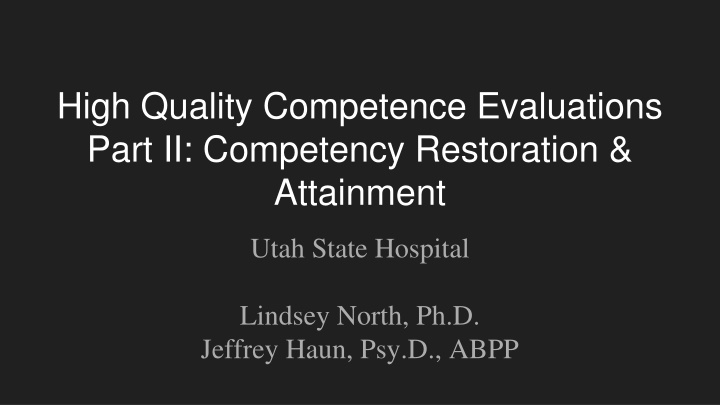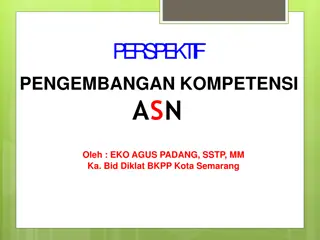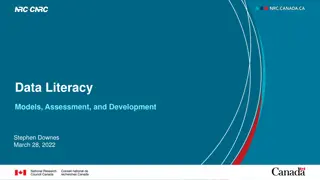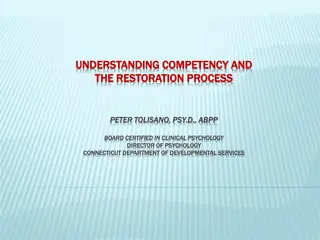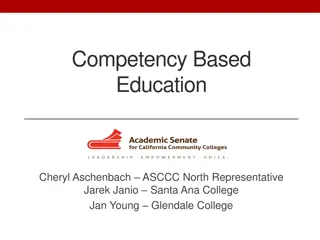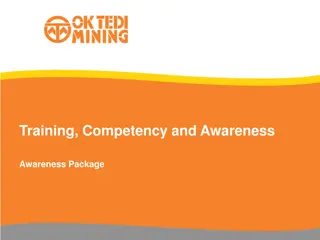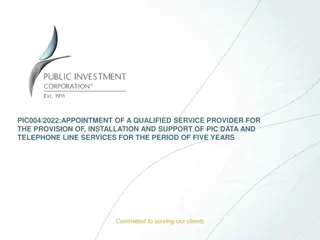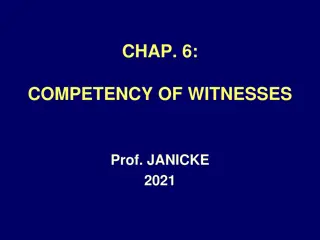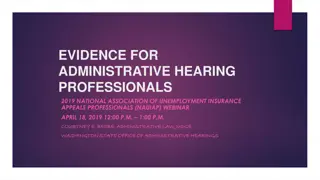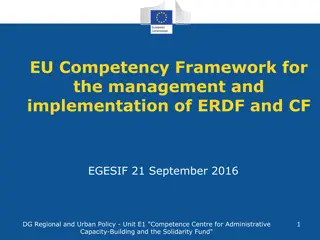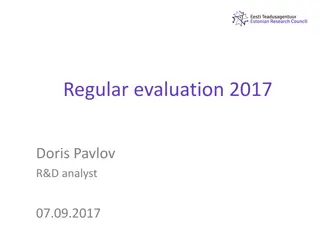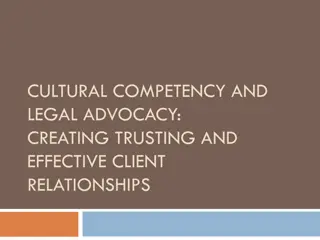Competency Evaluation Process: A Comprehensive Overview
This document delves into the process of competency evaluations, specifically focusing on competency restoration and attainment at Utah State Hospital. It covers key steps such as petition, order for evaluation, findings of incompetency, competency restoration treatment, and review. It outlines the criteria for a defendant to be deemed competent to stand trial and explores the literature on adult competency evaluations. The evaluation process, considerations for incompetency, and remediation/restorability factors are discussed in detail.
Download Presentation

Please find below an Image/Link to download the presentation.
The content on the website is provided AS IS for your information and personal use only. It may not be sold, licensed, or shared on other websites without obtaining consent from the author.If you encounter any issues during the download, it is possible that the publisher has removed the file from their server.
You are allowed to download the files provided on this website for personal or commercial use, subject to the condition that they are used lawfully. All files are the property of their respective owners.
The content on the website is provided AS IS for your information and personal use only. It may not be sold, licensed, or shared on other websites without obtaining consent from the author.
E N D
Presentation Transcript
High Quality Competence Evaluations Part II: Competency Restoration & Attainment Utah State Hospital Lindsey North, Ph.D. Jeffrey Haun, Psy.D., ABPP
Road Map 1. Petition 2. Order 3. Evaluation 4. Finding of Incompetency 5. Competency Restoration Treatment 6. Review
Petition UCA 77-15-3 Filed in good faith and on reasonble grounds Based upon knowledge or information and belief Shall contain a recital of facts, observations, and conversations that form basis of petition
Order for Evaluation of Competence to Proceed UCA 77-15-5(2)(f): If court finds the allegations raise a bona fide doubt as to competency, Court shall order DHS to complete evaluation: Typically one evaluator Two evaluators for capital felonies or felonies in which court determines second evaluation necessary Additional evaluations at expense of requesting party FY22: 578 orders to DHS for initial evaluation of CTP (574 defendants)
Evaluation UCA 77-15-2: Competent to stand trial means the defendant has: a) A rational and factual understanding of the criminal proceedings against the defendant and of the punishment specified for the offense charged; and b) The ability to consult with the defendant's legal counsel with a reasonable degree of rational understanding in order to assist in the defense
Adult Competency Evaluation Literature Average rates of incompetendcy range from 20 to 30 percent across most studies Considerable variability across settings and defendant populations A few salient characteristics of defendant s adjudicated ICST: Severe symptomatology Intellectual/cognitive limitations History of inpatient hospitalization
Remediation/Restorability UCA 77-15-6: If it is the opinon of the forensic evaluator that the defendant is incompetent to proceed, s/he must indicate: The factors that contribute to incompetency Whether there is a substantial probability that restoration treatment may, in the forseeable future, bring the defendant to competency Or that the defendant cannot become competent in the forseeable future
Finding of Incompetency UCA 77-15-6: Defendant s adjudicated as incompetent to proceed shall be committed to DHS for restoration treatment FY22: 248 orders for restoration Restoration treatment shall be sufficient in scope and duration to: Restore the individual to competency in the foreseeable future; or Determine whether the defendant can be restored to competency in the foreseeable future Court may recommend, but not order placement in a specific program Can order placement be a secure setting
USH Competency Restoration Treatment Continuum Screening: Screening must be completed within 72 hours of receipt of commitment order Conducted by DHS-ORP clinicians Review of records (e.g., petition, competency evaluation, court findings) Interview of defendant typically in jail setting Screening tool Clinician determines placement in one of three DHS-USH restoration program Defendant must be admitted to facility within two weeks
DHS Competency Restoration Treatment Continuum Utah State Hospital (USH) Provo, Utah Inpatient psychiatric treatment facility Five forensic treatment units (124 beds) Multidisciplinary treatment teams
DHS Competency Restoration Treatment Continuum Competency Restoration Unit (CRU) Salt Lake County Adult Detention Center One unit (22 beds) Clinical program/services provided by USH social workers and recreation therapists Medication managed in partnership with ADC/USH psychiatry
DHS Competency Restoration Treatment Continuum Outreach Restoration Program (ORP) Restoration treatment/education provide to persons in variety of settings through the state: Outpatient/community settings County jails Utah State Prison ORP clinicians meet with defendants in-person and/or via telehealth platforms Psychiatric medication is arranged through community mental health resources
Competency Restoration Treatment Quality restoration treatment is individually tailored to a defendant's competence-related functional deficits Most often combination of psychiatric treatment and legal education Individual and group treatment modalities Intervention should focus on factual AND rational understanding of the proceedings/allegations Rote memorization of legal concepts is not sufficient (e.g., U.S. v. Duhon, 2003)
Competency Restoration Treatment Psychiatric medication is a primary intervention for many defendants Involuntary administration of antipsychotic medication: Washington v. Harper (1990): Permits the State to involuntarily administer antipsychotic medication against an inmates will if s/he is dangerous to self/others and the treatment is in the person s medical interest. U.S. v. Sell (2003): Permits the State to override a defendant s refusal of antipsychotic medication for the sole purpose of restoring competency to stand trial under limited circumstances
Competency Restoration Literature Most defendants who undergo competency restoration treatment are restored to competence ~ 80 to 90 percent in less than six months Variable rates/length of treatment across diagnoses Below average probability of restoration (Mossman, 2007): Chronic psychosis with history of lengthy inpatient hospitalizations Incompetency stemming from irremediable cognitive/intellectual impairments
Non-restorability A minority of defendants are ultimately deemed unrestorable Depends on a variety of factors: Nature and intensity of symptoms/impairments Case-specific factors Treatment options/amenability Availability of treatment/programming Length of treatment/treatment progress Statutory time frames
Jackson v. Indiana (1972) Defendants committed solely on the basis of incompetency cannot be held more than the reasonable period of time necessary to determine whether there is a substantial probability the [he/she] will attain that capacity in the foreseeable future Continued confinement must be justified by progress Most jurisdiction place limits on maximum time a defendant can be held for the purposes of competency restoration treatment
Utah Restoration Limits UCA 77-15-6(1) A defendant may not be held for restoration treatment longer than: The time necessary to determine (1) if there is a substantial probability of restoration in the foreseeable future or (2) that hat the defendant cannot become competent in the foreseeable future The maximum period of incarceration possible if convicted of most serious offense Charges dismissed and civil commitment often follows if statutory restoration limits are met or defendant is determined to be non-restorable See Competency Flowchart
Progress Toward Competency Evaluations Assessment of progress is an ongoing component of restoration treatment Defendant s are referred for updated evaluation of competency to proceed: To meet statutory timeframes (e.g., 90 days) When a defendant is judged to have possible attained competency or appears unlikely to restore Conducted by qualified DHHS forensic evaluators Not involved in defendant s treatment [UCA 77-15-2(4)]
Progress Toward Competency Evaluations 90 day A progress toward competency evaluation must be submitted within 90 of commitment order [UCA 77-15-6(2)] Report must: Assess what progress the defendant has made toward competency restoration, with respect to the factors identified by the court in its initial order Assess the facility's or program's capacity to provide appropriate restoration treatment for the defendant Assess the nature of restoration treatment provided to the defendant Assess the likelihood of restoration to competency, the amount of time estimated to achieve competency, or the amount of time estimated to determine whether restoration to competency may be achieved
Competency Review Hearing (UCA 77-15-6(6-12)) A hearing must be held within 15 days of receipt of 90-day progress report May order continued commitment to DHHS for restoration treatment if the defendant is determined to remain incompetent to proceed and there is a substantial probability of restoration in the foreseeable future Must hold another review hearing within three months If defendant remains incompetent at second review hearing: Cannot extend commitment again, except for 1stdegree felony, aggravated murder, attempted murder, or manslaughter charges
Competency Review Hearing (UCA 77-15-6(6-12)) Cannot extend commitment again if defendant remains incompetent at second review hearing Exception: May extent up to 9 months for 1stdegree felony, attempted murder, or manslaughter charges May extend an additional 24 months if charged with murder or aggravated murder
Juvenile Competency Attainment in Utah Background & Process: 1. Petition for competency evaluation a. Helpful if includes brief information related to actual competency deficits observed by attorney b. More challenging if attorney has never spoken to the youth and relies on parent s report
Juvenile Competency Attainment in Utah Background & Process: 2. Competency Evaluation a. b. Identification of specific psycholegal deficits Identification of cause of deficits: intellectual disability or related condition, mental illness, developmental immaturity (incomplete: immature compared to adults vs. delayed: immature compared to same aged peers)
Juvenile Competency Attainment in Utah Background & Process: 3. Findings of Fact a. Competent: continue with the legal process b. Incompetent without substantial likelihood of attainment: UCA 80-6-402(14)(d) If the juvenile court enters a finding (not competent not attainable) the court shall terminate the competency proceeding, dismiss the charges against the minor without prejudice, and release the minor from any custody order related to the pending proceeding, unless the prosecutor is seeking commitment proceedings.
Juvenile Competency Attainment in Utah 3. Findings of Fact Continued c. Incompetent with a substantial likelihood of attainment: UCA 80-6-403(1) If the juvenile court determine that the minor is not competent to proceed, and there is a substantial likelihood that the minor may attain competency in the foreseeable future, the juvenile shall notify the department of the findings and allow the department 30 days to develop an attainment plan for the minor.
Juvenile Competency Attainment in Utah Attainment Once a youth is ordered to attainment, they are assigned to an attainment provider with DHHS and an attainment report is filed. The report includes: UCA 80-6-403(2) The attainment plan shall include information about: Any treatment or services the minor is getting or that will be necessary for competency attainment, and if caretakers can provide that Any special supervision or condition the minor needs for attainment The likelihood the minor will attainment competency and amount of time required
Juvenile Competency Attainment in Utah The attainment plan is provided to all involved parties Attainment must occur in the least restrictive setting Currently conducted in an outpatient or community based setting: the youth s school, probation office, detention center, or other appropriate location Competency progress reviewed every 90 days in an attainment report If curriculum is not complete or competence deficits still exist at 90 days, an additional 90 days of services can be provided
Juvenile Competency Attainment in Utah Attainment Curriculum Research-based and developed in conjunction with the University of Utah in 2019 Sessions provided at least once per week as possible Elements of factual, rational, and ability to consult with counsel included in curriculum Uses a module system and regular quizzes to assess the minor knowledge and ability to apply information to their case
Juvenile Competency Attainment in Utah Progress Towards Competency UCA 80-6-403(11) At the conclusion of a 6 month attainment period DHHS provides an updated competency evaluation to advise the court of the youth s progress If youth is competent the legal process continues If youth is incompetent they can have an additional six months of attainment services for a total of one year from date of order
Competency Attainment in Utah Community based attainment curriculum increased rates of attainment from 28% to 85% and decreased time receiving services from 222 to 130 days Attainment is not completely effective, but can be made much more effective with structure and a research based approach
Competency Attainment In Youth Rates of attainment in the United States Most youth tend to attain competency (approximately 75%) Depends on youth specific factors, which drops rates from below 10% to around 50% Could also depend on external factors, such as connection to community MH resources As an example, Arizona s Maricopa County attainment program is effective in attaining competency for 77% of participants
Factors Related to Attainment/Remediation Before services Youth less likely to be found competent: Under 15 Diagnosis of neurodevelopmental disorder (ADHD, Autism, ID) Specific problems with reasoning through different options and long term outcomes
Factors Related to Attainment/Remediation Before services More likely to be found competent to proceed: Age 16 or 17 Diagnosis of mood, substance, or psychotic disorder History of treatment One study found females of Hispanic descent more likely than similar males
Factors Related to Attainment/Remediation After attainment/remediation services Less likely to attain: Younger adolescents Youth with ID and a mental disorder Higher IQ more likely to attain
Forming an opinion about attainment For adults or juveniles, it is often quite difficult to form an opinion about competency to proceed Evaluators may consider: age, developmental level, current treatment status, historical response to treatment, ability to learn and benefit from academic intervention, willingness to participate, effort, feigning
Forming an opinion about attainment Despite limited research indicating much more than tendencies, in Utah we must provide an opinion: UCA 80-6-402(9)(c): whether there is a substantial likelihood the minor may attain competency in the foreseeable future.
Forming an opinion about attainment What does substantial mean? It seems to suggest more likely than not or more What does foreseeable future mean? Based on time frames discussed earlier, approximately one year
Forming an opinion about attainment High quality opinions contain: a. A clear conclusion with statutory language i. Not a chance of attainment b. Data to support the conclusion i. Data should be consistent with the rest of the report ii. There should be enough data to support the conclusion c. Consideration of alternatives
References Bath, E., Reba-Harrelson, L., Peace, R., Shen, J., & Liu, H. (2015) Correlates of Competency to Stand Trial Among Youths Admitted to a Juvenile Mental Health Court. Journal of the American Academy of Psychiatry and the Law Online 43 (3), 329-339. Chien, J. et al. (2016). Predictors of Competency to Stand Trial in Connecticut s Inpatient Juvenile Competency Restoration Program. Journal of American Academy of Psychiatry and Law. 44. 451-456. Kruh at al. (2022). Community-based remediation of juvenile competence to stand trial: A national survey. International Journal of Forensic Mental Health. DOI: 10.1080/14999013.2021.2007431 Warren, J. et al.(2019). The Competency Attainment Outcomes of 1,913 Juveniles Found Incompetent to Stand Trial. Journal of Applied Juvenile Justice Services
